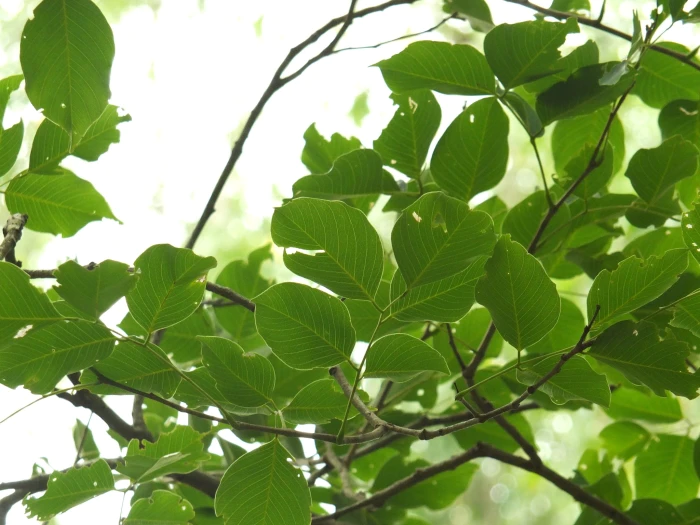Malabar Kino
(Pterocarpus marsupium)
Malabar Kino (Pterocarpus marsupium)
/
/

© Siddarth Machado
CC BY 4.0
Image By:
© Siddarth Machado
Recorded By:
Copyright:
CC BY 4.0
Copyright Notice:
Photo by: © Siddarth Machado | License Type: CC BY 4.0 | License URL: http://creativecommons.org/licenses/by/4.0/ | Uploader: siddarthmachado | Publisher: iNaturalist |

























Estimated Native Range
Climate Requirements for Midland, Texas
| This Plant | Your Site | Plant Suitability for Your Location | ||
|---|---|---|---|---|
| • Precipitation | 22" - 146" | 15" | Your precipitation may be insufficient for this plant. Irrigate N" / year. | Irrigate N" / year |
| • High Temp. | 71°F - 109°F | 95°F | Your summer temperatures are normal for this plant. | Excellent |
| • Low Temp. | 41°F - 72°F | 29°F | Your winter temperatures may be too cold for this plant | Too cold |
This plant should grow well at your location with about N inches per year (Y minutes per month) of irrigation.
Summary
Pterocarpus marsupium, commonly known as Malabar kino or Indian kino, is a deciduous tree native to dry deciduous forests and moist deciduous forests, particularly in the Western Ghats, central Indian forests, and parts of Sri Lanka. It can grow up to 102 feet (31 meters) in height, with a notable trunk diameter that can reach up to 6 feet (1.8 meters). The tree is characterized by its large, spreading crown and flaky, grey-brown bark. It produces small yellow flowers arranged in dense, axillary panicles, which are followed by flat, winged, woody pods. The flowering season is typically from March to May, and while the flowers are not particularly showy, they are of ecological importance as they attract pollinators.
Malabar kino is valued for its medicinal properties, as the tree exudes a red resin known as kino gum, which has been used in traditional medicine for its astringent qualities. The wood is durable and termite-resistant, making it suitable for construction, furniture, and agricultural implements. In cultivation, it requires a tropical climate and thrives in well-drained soils, tolerating a range of soil types from poor to fertile. It is relatively drought-tolerant once established but benefits from regular watering during the initial growth phase. Full sun is optimal for its growth. While not commonly used in small gardens due to its size, it is suitable for reforestation projects and as a shade tree in large landscapes. Potential problems include susceptibility to leaf spot and fungal diseases, especially in conditions of high humidity.CC BY-SA 4.0
Malabar kino is valued for its medicinal properties, as the tree exudes a red resin known as kino gum, which has been used in traditional medicine for its astringent qualities. The wood is durable and termite-resistant, making it suitable for construction, furniture, and agricultural implements. In cultivation, it requires a tropical climate and thrives in well-drained soils, tolerating a range of soil types from poor to fertile. It is relatively drought-tolerant once established but benefits from regular watering during the initial growth phase. Full sun is optimal for its growth. While not commonly used in small gardens due to its size, it is suitable for reforestation projects and as a shade tree in large landscapes. Potential problems include susceptibility to leaf spot and fungal diseases, especially in conditions of high humidity.CC BY-SA 4.0
Plant Description
- Plant Type: Tree
- Height: 30-100 feet
- Width: 50-70 feet
- Growth Rate: Moderate
- Flower Color: Yellow
- Flowering Season: Spring, Summer
- Leaf Retention: Deciduous
Growth Requirements
- Sun: Full Sun
- Water: Medium
- Drainage: Medium, Fast
Common Uses
Bee Garden
Natural Habitat
Native to dry deciduous forests and moist deciduous forests in the Western Ghats, central Indian forests, and parts of Sri Lanka
Other Names
Common Names: Indian Kino, Vijayasar, Indian Kinotree, Malabar Kino, Bijasal, Gammalu, East Indian/Malabar Kino
Scientific Names: Pterocarpus marsupium, Lingoum marsupium, Pterocarpos marsupius
GBIF Accepted Name: Pterocarpus marsupium